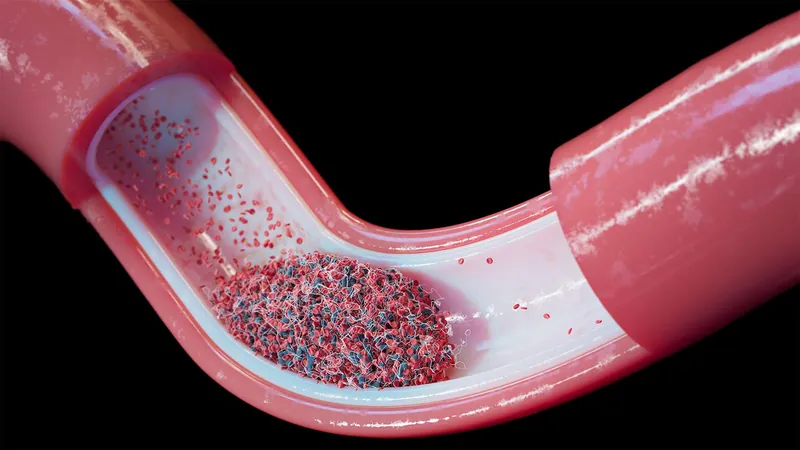
New Research Reveals Intra-Arterial Lytics Fail to Enhance Outcomes After Stroke Thrombectomy
2025-01-13
Author: Sarah
Recent research involving mechanical thrombectomy for stroke treatment has revealed that adjunctive intra-arterial thrombolytics, specifically urokinase and tenecteplase, do not significantly improve patient outcomes. This conclusion emerges from two pivotal randomized trials, POST-UK and POST-TNK, both involving over 500 participants and conducted across nearly 36 hospitals in China between 2022 and 2024.
In the POST-UK trial, a slight trend suggested better outcomes with intra-arterial urokinase—a periprocedural injection—but the differences did not achieve statistical significance. Results indicated that 45.1% of patients receiving urokinase experienced survival without disability at 90 days compared to 40.2% in the control group. The adjusted risk ratio was 1.13, with a 95% confidence interval (CI) of 0.94-1.36.
Similarly, the POST-TNK trial involving intra-arterial tenecteplase found no statistically significant increase in the proportion of patients achieving optimal functional outcomes—rated on the modified Rankin Scale. Here, the figures were 49.1% for the tenecteplase group versus 44.1% for controls, with an adjusted risk ratio of 1.15 and a 95% CI of 0.97-1.36.
While these agents showed no increase in mortality or severe intracranial hemorrhaging, the POST-TNK trial noted a concerning rise in any radiologic intracranial hemorrhage within 48 hours among tenecteplase recipients—36.6% versus 27.3% for the control group, with an adjusted risk ratio of 1.33 (95% CI 1.04-1.69).
The hypothesis behind using intra-arterial thrombolytics stems from the idea that successful reperfusion of larger vessels does not necessarily translate to improved blood flow in the microvasculature, which is crucial for minimizing post-stroke disability. Researchers posited that administering these lytics might dissolve small embolic fragments, enhancing microvascular perfusion.
Interestingly, earlier studies such as the CHOICE trial hinted that intra-arterial alteplase could benefit stroke patients with nearly complete reperfusion, although that trial's early termination left much ambiguity regarding its efficacy.
The authors of the current studies assert that the evidence does not yet validate the routine use of intra-arterial thrombolytics in clinical settings. Nevertheless, they commend the initiative behind both trials and suggest the need for further research, including ongoing studies like the TECNO trial, which is examining tenecteplase, and the 2BE3 trial, which explores various interventions for distal vessel control during thrombectomy.
Both POST-UK and POST-TNK focused on adult stroke patients with proximal intracranial large vessel occlusion, who underwent thrombectomy within 24 hours of symptom onset and had not received intravenous thrombolysis beforehand. In the POST-UK trial, involving 534 patients, the median participant age was 69, with 41.8% being women. In POST-TNK, 540 patients were randomized, with similar demographics reported.
Evaluating 90-day mortality rates revealed no significant differences: 18.4% in the urokinase group versus 17.3% in controls for POST-UK, and 16% versus 19.3% for POST-TNK's tenecteplase cohort. Both studies also acknowledged the limitations of being open-label trials, raising questions about the generalizability of their findings, particularly for populations that received intravenous thrombolytics before undergoing thrombectomy.
As research in this critical field continues, stroke patients and their caregivers remain hopeful for advancements that enhance recovery outcomes and restore quality of life post-stroke. Stay tuned for further updates as more studies unfold!


 Brasil (PT)
Brasil (PT)
 Canada (EN)
Canada (EN)
 Chile (ES)
Chile (ES)
 Česko (CS)
Česko (CS)
 대한민국 (KO)
대한민국 (KO)
 España (ES)
España (ES)
 France (FR)
France (FR)
 Hong Kong (EN)
Hong Kong (EN)
 Italia (IT)
Italia (IT)
 日本 (JA)
日本 (JA)
 Magyarország (HU)
Magyarország (HU)
 Norge (NO)
Norge (NO)
 Polska (PL)
Polska (PL)
 Schweiz (DE)
Schweiz (DE)
 Singapore (EN)
Singapore (EN)
 Sverige (SV)
Sverige (SV)
 Suomi (FI)
Suomi (FI)
 Türkiye (TR)
Türkiye (TR)
 الإمارات العربية المتحدة (AR)
الإمارات العربية المتحدة (AR)